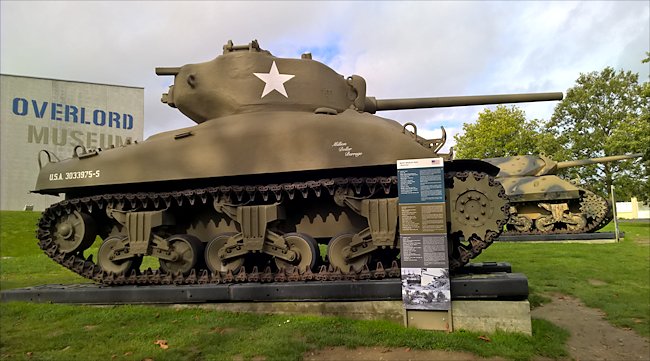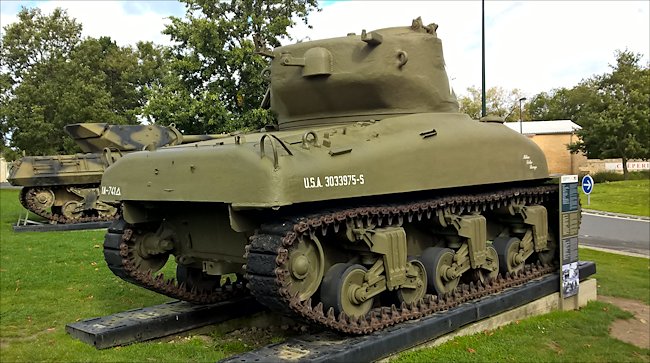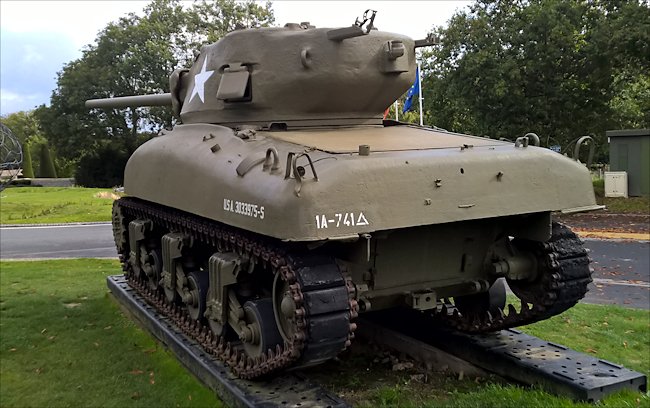Overlord Museum M4A1 Sherman Tank
This Restored M4A1 Sherman Tank outside the Overlord Museum near Omaha Beach in Normandy was fitted with the larger 76mm long barreled gun rather than the standard short 75mm, It was more powerful but still had to be within 450 m of a German Tiger Tank to have a chance of piercing its frontal armour. Any further away and the armour piercing round would not go through its 100mm thick armour.

M4A1 76mm Sherman tank outside the Overlord Museum next to a M10 Wolverine tank destroyer.
Location
The nearest village to the Overlord Museum is Colleville-sur-Mer. It is on the D514 costal road Hameau du Bray. You cannot miss it as there is a M4A1 Sherman tank, M10 Wolverine Tank Destroyer and British Sexton self-propelled artillery gun outside the front by the roundabout. It is very near Omaha Beach and the American Military Cemetery.

M4A1 76mm Sherman tank in Colleville-sur-Mer
Specification
The M4A1 Sherman Tank armour thickness ranged for 25 mm to 75 mm. It was armed with the standard 75 mm M3 L/40 gun and two 30-06 Browning machine guns, one in the hull and the other next to the main gun in the turret.
It was powered by a petrol Continental R975 C1 9 cylinder radial engine that produced 400 hp. It had a top road speed of 30 mph (48 km/h). It had an operational range of around 120 miles (193 km) The tank had a crew of five, commander, driver, gunner, loader and co-driver/machine gunner.

M4A1 Sherman tank with cast hull and turret.
The Tiger tank Vs M4A1 Sherman 76mm tanks
In 1944 in Normandy the German Tiger I Tank could penetrate the M4A1 Sherman tank's front armour at 1800m. The Sherman tanks short barrelled 75mm gun could not penetrate the Tiger I's front armour at any distance.
On the Eastern Front the Tiger I's 88mm gun could penetrate the Soviet T34/85 at 1400m. The T34/85 Tanks 85mm gun had to be within 500m before its shells could penetrate the Tiger I's front armour.
The M4A1 Sherman tanks long barrelled high velocity 76mm gun had to be within 700m before its shells could penetrate the Tiger I's 100mm frontal armour. The British Sherman Fireflys' 17 pounder anti-tank gun was much more powerful than the American 76mm gun. It could penetrate the Tiger I's front armour at 1750m.

This M4A1 Sherman tank is fitted with a 76 mm gun
Sherman Tank Design Improvements
User experience led to numerous design improvements being suggested by the Armored Force and incorporated into M4 series vehicles by the Ordnance Department. Foremost among these were the need for a more powerful gun and better protection. Improved features introduced to the M4 series were as follows.
76mm gun: To increase firepower the Ordnance Department developed the 76mm gun M1 and M1A1, starting in July 1942. Tests showed that the existing M4 series turret was too small to accommodate the extra length of this weapon and the turret of the T20/T23 medium tank was adopted and suitably modified. The 76mm gun installation was standardised and introduced in production lines from February 1944 and vehicles so fitted were available in time for the Normandy landings and subsequent combat in NW Europe. Suffix '(76mm)' indicated vehicles with this gun. A modified 76mm gun MIA IC or MIA2 with muzzle-brake was later introduced.
Protection : Fire hazard from hits in the engine, ammunition bins, and fuel tanks was the major shortcoming in the M4 series due to the relatively thin armour. Expedient measures to combat this were the addition of applique armour plates on hull sides adjacent to ammunition bins and fuel tanks, plus further appliqué armour welded on hull, and sometimes turret, front. Field modifications by crews included the use of sandbags on hull front and the welding of spare track shoes in vulnerable spots. In some instances large armour shields or concrete were added to hull fronts. Major design change to overcome the problem was the introduction of 'wet stowage' (glycerine-protected) ammunition racks in 76mm-armed and late 75mm-armed vehicles. Howitzer-armed vehicles had internal armour plates on ammunition racks.
Suspension: Introduction of the heavier gun and other improvements increased the vehicle's all-up weight with adverse effects on the ride. In 1943 a new wider (23in) T80 track was developed with centre line guides. At the same time a new horizontal volute spring suspension (HVSS) was designed to replace the vertical volute type. Bogies were dimensionally similar, but there were four wheels to each and the horizontal springs were tougher than the old vertical springs. Return rollers were now mounted on the hull sides. HVSS was designed so that any wheel could be replaced without removing the complete bogie concerned. HVSS was introduced from mid 1944. Vehicles so fitted had track covers on the hull sides due to increased width of the tracks. The original track for the M4 series had incorporated rubber blocks, but to overcome rubber shortage steel tracks were designed, in two different patterns. They were inter-changeable with the rubber tracks and all three types could be seen on M4s. To improve ride in muddy conditions, grousers could be fitted to the outer edge of these earlier tracks, giving increased effective width. With T80 tracks grouseres were not supplied, though later developed.
105mm Howitzer: For the close support role a 105mm howitzer was contemplated and two M4A4s were modified to take this in November 1942. This was standardised in 1943 for production.
Miscellaneous: Other improvements included better electrical wiring, and other internal detail changes, a new 470 hull front to simplify production (it also improved frontal protection), larger access hatches for driver and co-driver, a loader's hatch, and the provision of a vision cupola for the commander replacing the rotating hatch ring originally fitted.
D-Day 1944 books

